relevant Publications
Find here relevant scientific publications and technical articles – including from TherVacB project partners. Scroll down to read more about chronic hepatitis B, the virus, screening and testing for hepatitis C and B, therapeutic vaccination, and cure research.
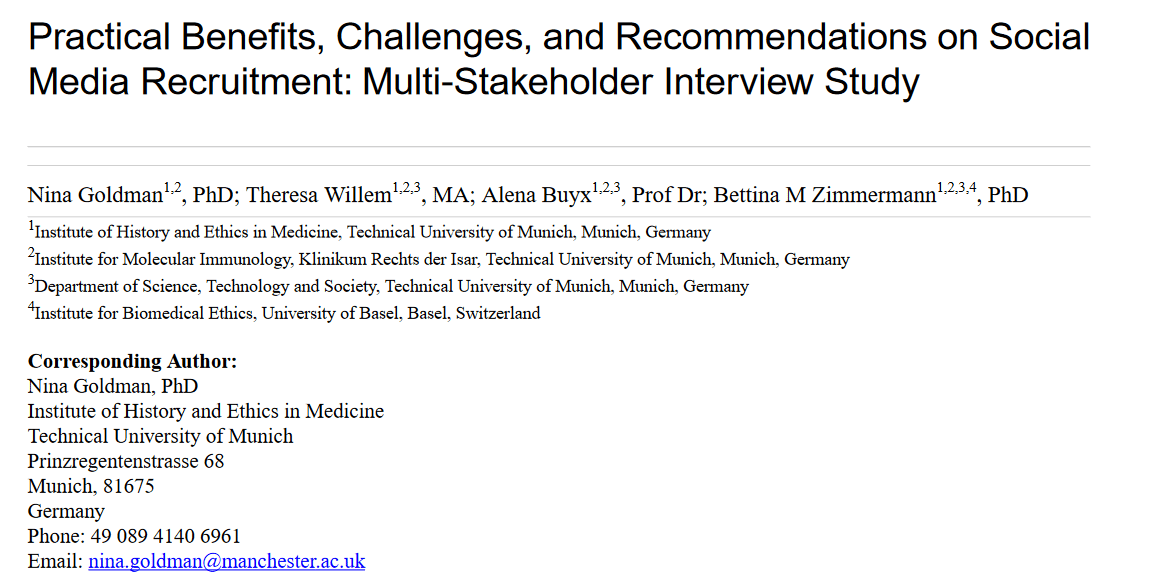
Practical Benefits, Challenges, and Recommendations on Social Media Recruitment: Multi-Stakeholder Interview Study
The increasing use of social media opens new opportunities for recruiting patients for research studies. Based on semi-structured interviews with both people using social media and living with hepatitis B as well as experts in a range of disciplines, authors are exploring the practical benefits of recruiting study participants with social media and are sharing an expert summary on how to conduct social media-based recruitment. Generally, a multiplatform approach with mixed-methods recruitment is the most beneficial recruitment strategy for many research studies. The different recruitment methods complement each other and may contribute to improving the reach of the study, the recruitment accrual, and the representativeness of the sample. Importantly, an assessment of the context- and project-specific appropriateness and usefulness of social media recruitment should be carried out before designing the recruitment strategy.
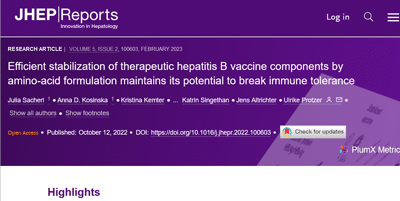
Efficient stabilization of therapeutic hepatitis B vaccine components by amino-acid formulation maintains its potential to break immune tolerance
February 2023 | Journal of Hepatology
Induction of potent, HBV-specific immune responses is crucial to control and finally cure HBV. The therapeutic hepatitis B vaccine TherVacB combines protein priming with a Modified Vaccinia virus Ankara (MVA)-vector boost to break immune tolerance in chronic HBV infection. Particulate protein and vector vaccine components, however, require a constant cooling chain for storage and transport, posing logistic and financial challenges to vaccine applications. Authors of this article aimed to identify an optimal formulation to maintain stability and immunogenicity of the protein and vector components of the vaccine using a systematic approach. This will facilitate global vaccine application without the need for cooling chains and is important for the development of prophylactic as well as therapeutic vaccines supporting vaccination campaigns worldwide.
https://www.jhep-reports.eu/article/S2589-5559(22)00175-6/fulltext
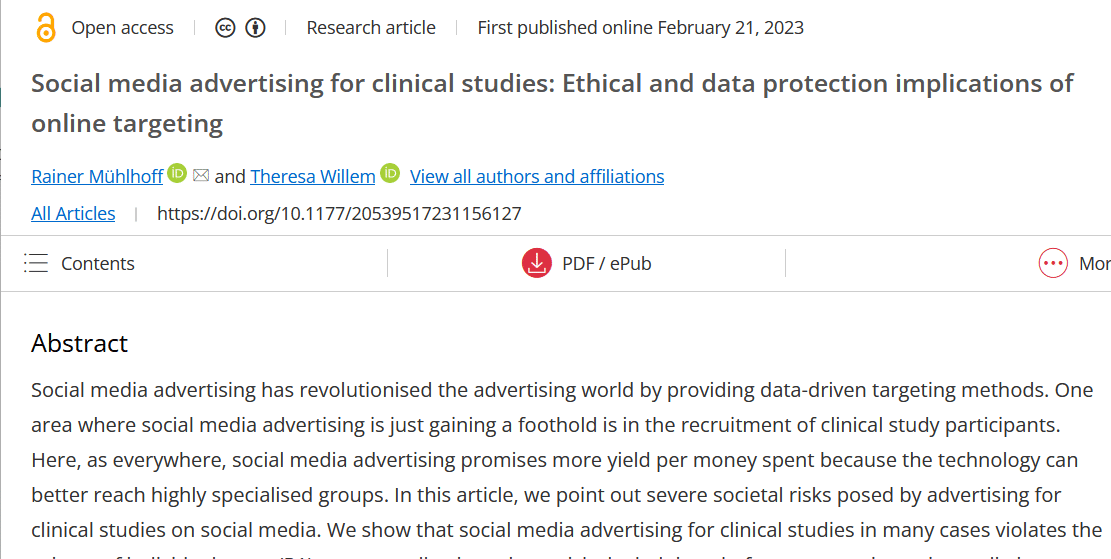
Social media advertising for clinical studies: Ethical and data protection implications of online targeting
21 February 2023 | Big Data & Society
Social media advertising is gaining a foothold in the recruitment of clinical study participants, promising more yield per money spent because the technology can better reach highly specialised groups. In this article, authors point out severe societal risks posed by advertising for clinical studies on social media and call for updates of research ethics guidelines and better regulation of Big Data and inferential analytics. In conclusion, social media advertising – especially with vulnerable patient populations – is deemed unsuitable as a recruitment tool for clinical studies as long as the processing of (even anonymised) social media usage data and the training of predictive models by data analytics and artificial intelligence companies is not sufficiently regulated.
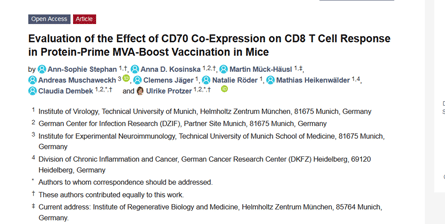
Bewertung der Auswirkung der CD70-Koexpression auf die CD8-T-Zell-Antwort bei der Protein-Prime-MVA-Boost-Impfung in Mäusen
21 January 2023 | Vaccines – Special Issue Hepatitis Virus Vaccine Immune Therapy
This article investigates the potential of CD70 co-expression during viral vector boost vaccination to improve an antigen-specific T cell response. In sum, the article presents a safe system to selectively enhance the vector-vaccine-induced CD8 T cell response to the target antigen through CD70 co-expression during boost immunization. In this respect, this study may contribute to the development and improvement of therapeutic vaccines revealing novel generic design principles and thus foster advances of current strategies to fight malignancies and persistent viral infections.
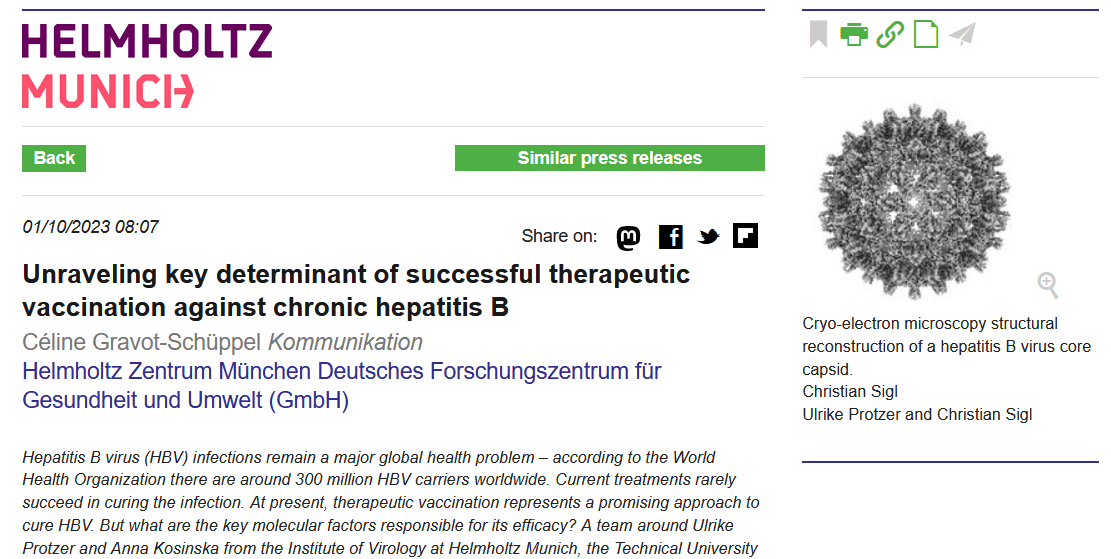
Activation of CD4 T cells during prime immunization determines the success of a therapeutic hepatitis B vaccine in HBV-carrier mouse models
9 January 2023 | Journal of Hepatology
Authors describe the recently developed a heterologous therapeutic vaccination scheme (TherVacB) comprising a particulate protein prime followed by a modified vaccinia-virus Ankara (MVA)-vector boost for the treatment of HBV. However, the key determinants required to overcome HBV-specific immune tolerance remain unclear. In this article, new combination adjuvants and unravel factors are studied that are essential for the antiviral efficacy of the TherVacB vaccination scheme.
Read more about the work by the team around Prof. Dr. Ulrike Protzer and Dr. Anna Kosinska here: https://idw-online.de/en/news807417
https://www.journal-of-hepatology.eu/article/S0168-8278(22)03465-1/fulltext#secsectitle0045
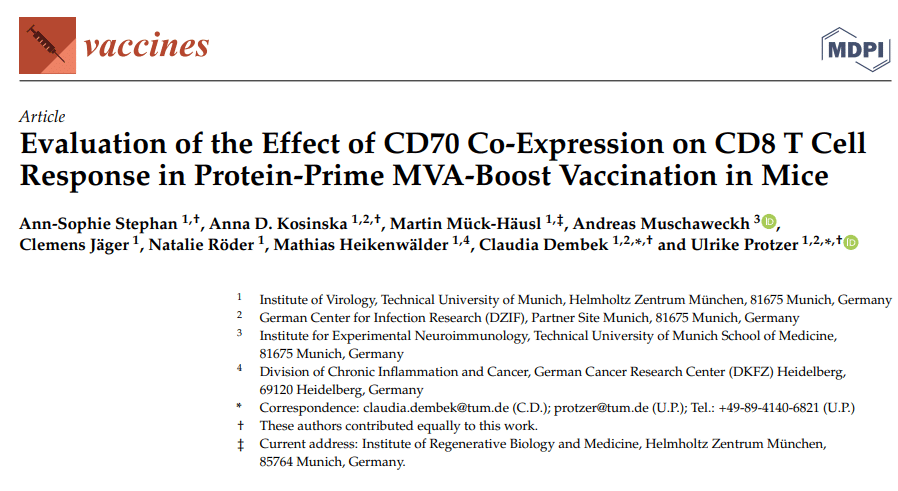
Bewertung der Auswirkung der CD70-Koexpression auf die CD8-T-Zell-Antwort bei der Protein-Prime-MVA-Boost-Impfung in Mäusen
21. Januar 2023 | Impfstoffe – Sonderausgabe Hepatitis-Virusimpfstoff Immuntherapie
In diesem Artikel untersucht das Forscherteam das Potenzial der Koexpression von CD70 während einer viralen Vektor-Boost-Impfung zur Verbesserung einer antigenspezifischen T-Zell-Antwort. Insgesamt deutet diese Studie darauf hin, dass die orchestrierte Koexpression von CD70 und einem Impfstoff-Antigen ein interessantes und sicheres Mittel sein kann, um antigenspezifische CD8-T-Zell-Antworten mit vektorbasierten Impfstoffen zu verstärken, obwohl dies in unserer Studie nicht ausreichte, um die Immuntoleranz zu brechen.
https://www.mdpi.com/2076-393X/11/2/245
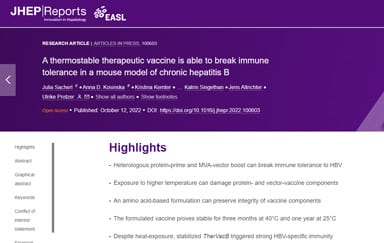
Ein thermostabiler therapeutischer Impfstoff ist in der Lage, die Immuntoleranz in einem Mausmodell für chronische Hepatitis B zu brechen
12. Oktober 2022 | Journal of Hepatology (JHEP) Reports
Die therapeutische Impfung ist eine vielversprechende Therapieoption für chronische Hepatitis B, die eine Heilung der chronischen Hepatitis B ermöglichen könnte. Ihre Anwendung erfordert jedoch funktionierende Kühlketten während des Transports und der Lagerung, die in vielen Ländern mit hoher Nachfrage kaum gewährleistet werden können. In dieser Studie haben die Autoren, darunter Julia Sacherl, Anna D. Kosinska und Ulrike Protzer, thermostabile Impfstoffkomponenten entwickelt, die gut verträglich sind und es ermöglichen, in präklinischen Mausmodellen Immunantworten zu induzieren und das Virus auch nach langfristiger Exposition gegenüber hohen Umgebungstemperaturen zu kontrollieren. Dies wird die Kosten senken und die Anwendung eines therapeutischen Impfstoffs erleichtern und somit den vielen Hepatitis-B-Patienten weltweit zugute kommen.
Lesen Sie mehr über die Arbeit des Teams im Labor von Prof. Protzer hier: https://www.dzif.de/en/chronic-hepatitis-b-development-thermostable-therapeutic-vaccine.
https://www.jhep-reports.eu/article/S2589-5559(22)00175-6/fulltext
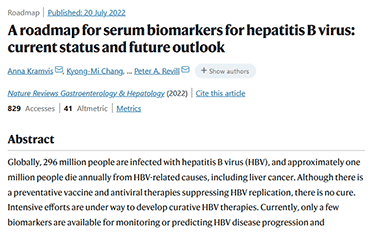
Ein Fahrplan für Serum-Biomarker für das Hepatitis-B-Virus: aktueller Stand und Zukunftsaussichten
Weltweit sind 296 Millionen Menschen mit dem Hepatitis-B-Virus (HBV) infiziert, und etwa eine Million Menschen sterben jährlich an HBV-bedingten Ursachen. Obwohl es einen präventiven Impfstoff und antivirale Therapien gibt, die die HBV-Replikation unterdrücken, gibt es keine Heilung. Es werden intensive Anstrengungen unternommen, um kurative HBV-Therapien zu entwickeln. Derzeit gibt es nur wenige Biomarker für die Überwachung oder Vorhersage des Fortschreitens der HBV-Erkrankung und des Ansprechens auf die Behandlung. In dem Maße, in dem neue Therapien zur Verfügung stehen, werden dringend neue Biomarker zur Überwachung der Reaktion von Virus und Wirt benötigt. In October 2020, the International Coalition to Eliminate Hepatitis B Virus (ICE-HBV) held a workshop on HBV biomarkers. Verschiedene Akteure aus der Wissenschaft, der klinischen Praxis und der pharmazeutischen Industrie mit sich ergänzenden Fachkenntnissen hielten Vorträge und nahmen an Podiumsdiskussionen teil, darunter Ulrike Protzer, Mala Maini und Florian van Bömmel. Dieser Fahrplan fasst die Stärken, Schwächen, Möglichkeiten und Herausforderungen von HBV-Biomarkern zusammen.
https://www.nature.com/articles/s41575-022-00649-z
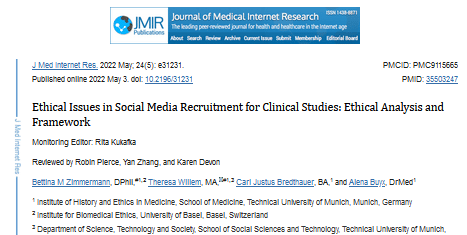
Ethische Fragen bei der Rekrutierung über soziale Medien für klinische Studien: Ethische Analyse und Rahmen
Bettina M Zimmermann, Theresa Willem, Carl Justus Bredthauer, Alena Buyx
Die Rekrutierung über soziale Medien für klinische Studien verspricht eine kosteneffiziente Methode zu sein, um traditionell marginalisierte Bevölkerungsgruppen anzusprechen und das Engagement der Patienten für Forscher und eine bestimmte Studie zu fördern. Die Nutzung sozialer Medien für die Rekrutierung von Teilnehmern an klinischen Studien wirft jedoch auch eine Reihe von ethischen Fragen auf. Die in diesem Beitrag zusammengefasste Studie soll einen umfassenden Überblick über die ethischen Vorteile und Risiken geben, die bei der Rekrutierung über soziale Medien in klinischen Studien zu berücksichtigen sind, und praktische Empfehlungen für die Umsetzung dieser Überlegungen entwickeln.
https://www.ncbi.nlm.nih.gov/pmc/articles/PMC9115665/
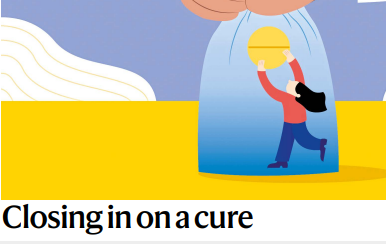
Einem Heilmittel für Hepatitis B auf der Spur
30 März 2022 | Nature
Elie Dolgin
Mit einer begrenzten Anzahl von Behandlungen könnte das Virus unter Kontrolle gebracht werden – mit der richtigen Kombination von Medikamenten.
Lesen Sie weiter, um mehr darüber zu erfahren, wie Ulrike Protzer und Mala Maini von TherVacB gemeinsam mit anderen führenden HBV-Wissenschaftlern, Virologen, Virusimmunologen und Hepatologen auf der ganzen Welt die Entwicklung eines auf die HBV-Heilung ausgerichteten Aktionsplans vorangetrieben haben, der auch die Perspektive der Patienten einbezieht.
https://www.nature.com/articles/d41586-022-00812-1
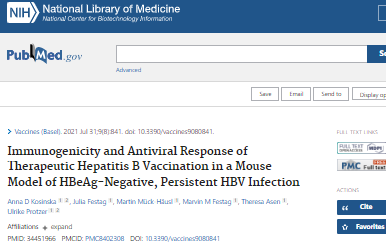
Immunogenität und antivirale Reaktion auf eine therapeutische Hepatitis-B-Impfung in einem Mausmodell mit HBeAg-negativer, persistierender HBV-Infektion
31 July 2021 | Vaccines
Anna D Kosinska, Julia Festag, Martin Mück-Häusl, Marvin M Festag, Theresa Asen, Ulrike Protzer
Während des natürlichen Verlaufs einer chronischen Infektion mit dem Hepatitis-B-Virus (HBV) geht das Hepatitis-B-e-Antigen (HBeAg) in der Regel verloren, während die direkte Übertragung von HBeAg-negativem HBV zu einer fulminanten Hepatitis B führen kann. Während die Induktion HBV-spezifischer Immunantworten durch therapeutische Impfung eine vielversprechende, neuartige Behandlungsmöglichkeit für chronische Hepatitis B darstellt, ist noch unklar, ob der Verlust von HBeAg die Wirksamkeit oder Verträglichkeit dieser Behandlung beeinflussen kann. Wir haben daher einen AAV-Vektor entwickelt, der ein 1,3-fach überlanges HBV-Genom mit einer typischen Stop-Codon-Mutation in der Prä-Core-Region trägt und die Replikation von HBeAg(-)-HBV in Mäuselebern initiiert. Die Infektion von C57BL/6-Mäusen führte zu einer persistenten HBeAg(-)-HBV-Replikation ohne nachweisbare Anti-HBV-Immunität oder Leberschäden. HBV-Trägermäuse wurden mit TherVacB immunisiert, einem therapeutischen Hepatitis-B-Impfstoff, der ein partikuläres HBV S und ein Kernprotein für die Grundimmunisierung und ein modifiziertes Vaccinia Ankara (MVA) für die Verstärkungsimpfung verwendet. Die TherVacB-Immunisierung von HBeAg(+) und HBeAg(-) HBV-Trägermäusen führte zu einer wirksamen Induktion von HBV-spezifischen Antikörpern und zum Verlust von HBsAg, aber nur zu leichten Leberschäden. Intrahepatische, HBV-spezifische CD8-T-Zellen, die in HBeAg(-)-Mäusen induziert wurden, exprimierten mehr IFNγ, zeigten aber eine ähnliche zytolytische Aktivität. Dies deutet darauf hin, dass der Verlust von HBeAg die Leistung der therapeutischen Impfung durch die Stärkung der nicht-zytolytischen Effektor-Funktionen verbessert.
https://pubmed.ncbi.nlm.nih.gov/34451966/
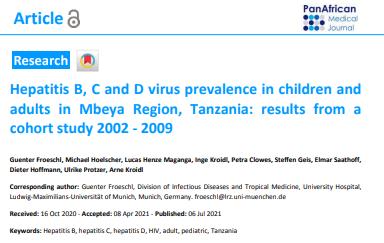
Hepatitis-B-, -C- und -D-Virusprävalenz bei Kindern und Erwachsenen in der Region Mbeya, Tansania: Ergebnisse einer Kohortenstudie 2002 - 2009
6 July 2021 | The Pan African Medical Journal
Guenter Froeschl, Michael Hoelscher, Lucas Henze Maganga, Inge Kroidl, Petra Clowes, Steffen Geis, Elmar Saathoff, Dieter Hoffmann, Ulrike Protzer, Arne Kroidl
In den afrikanischen Ländern südlich der Sahara ist die Prävalenz des Hepatitis-B-Virus (HBV) hoch. Ziel dieser Analyse ist es, die HBV-Belastung verschiedener Altersgruppen in der Region Mbeya in Tansania zu klären und die Prävalenz von Hepatitis-C- (HCV) und Hepatitis-Delta-Antigen- (HDV) Infektionen zu bestimmen.
https://www.panafrican-med-journal.com/content/article/39/174/full/

Screening auf Hepatitis B und C gehört jetzt zur Gesundheitsvorsorge
17 June 2021 | Der Hausarzt.DIGITAL
Ulrike Protzer
Kürzlich wurden Tests auf Hepatitis B und C in die Gesundheitsvorsorge („Check-up“) aufgenommen. Versicherte ab 35 Jahren können sich einmalig auf diese beiden Erkrankungen untersuchen lassen. Dr. med. Ulrich Scharmer sprach darüber mit der Virologin Prof. Dr. med. Ulrike Protzer, München.
https://www.hausarzt.digital/medizin/praevention/screening-auf-hepatitis-b-und-c-gehoert-jetzt-zur-gesundheitsvorsorge-95051.html
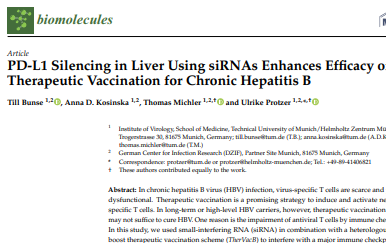
Ausschaltung von PD-L1 in der Leber mit siRNAs erhöht die Wirksamkeit der therapeutischen Impfung gegen chronische Hepatitis B
18 March 2021 | Biomolecules
Till Bunse, Anna D. Kosinska, Thomas Michler and Ulrike Protzer
Bei einer chronischen Infektion mit dem Hepatitis-B-Virus (HBV) sind die virus-spezifischen T-Zellen rar und teilweise dysfunktional. Die therapeutische Impfung ist eine vielversprechende Strategie, um neue virusspezifische T-Zellen zu induzieren und zu aktivieren. Bei langjährigen oder hochgradigen HBV-Trägern reicht die therapeutische Impfung allein jedoch möglicherweise nicht aus, um HBV zu heilen. Ein Grund dafür ist die Beeinträchtigung der antiviralen T-Zellen durch Immun-Checkpoints. In dieser Studie haben wir small-interfering RNA (siRNA) in Kombination mit einem heterologen therapeutischen Impfschema (TherVacB) verwendet, um einen wichtigen Immun-Checkpoint, die Interaktion von programmiertem Todesprotein-1 (PD-1) und seinem Liganden (PDL-1), zu stören. Bei Mäusen, die nach einer Infektion mit einem Adeno-assoziierten Virus, das das HBV-Genom enthält, persistent HBV replizieren, führte siRNA, die auf PD-L1 abzielt, zu einer höheren Funktionalität HBV-spezifischer CD8+ T-Zellen nach einer therapeutischen Impfung und ermöglichte eine nachhaltigere antivirale Wirkung und Kontrolle von HBV im peripheren Blut und in der Leber. Die antivirale Wirkung war ausgeprägter, wenn PD-L1 während der Grundimmunisierung herunterreguliert wurde als während der Boost-Impfung. Thus, targeting PD-L1 using siRNA is a promising approach to enhance the efficacy of therapeutic vaccination and finally cure HBV.
https://www.mdpi.com/2218-273X/12/3/470
